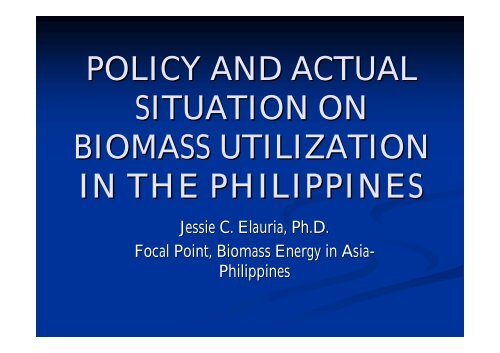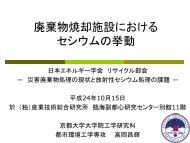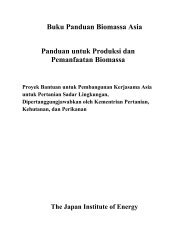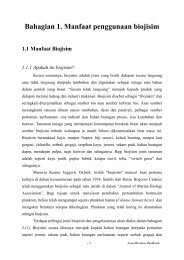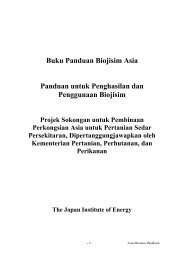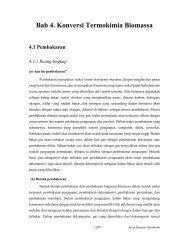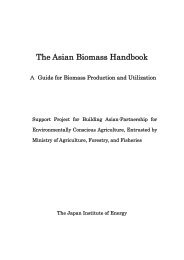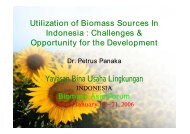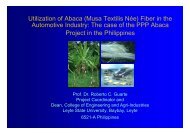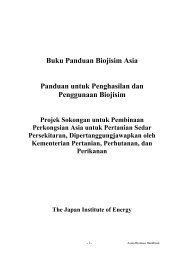POLICY AND ACTUAL SITUATION ON BIOMASS UTILIZATION IN ...
POLICY AND ACTUAL SITUATION ON BIOMASS UTILIZATION IN ...
POLICY AND ACTUAL SITUATION ON BIOMASS UTILIZATION IN ...
- No tags were found...
Create successful ePaper yourself
Turn your PDF publications into a flip-book with our unique Google optimized e-Paper software.
<strong>POLICY</strong> <strong>AND</strong> <strong>ACTUAL</strong><strong>SITUATI<strong>ON</strong></strong> <strong>ON</strong><strong>BIOMASS</strong> UTILIZATI<strong>ON</strong><strong>IN</strong> THE PHILIPP<strong>IN</strong>ESJessie C. Elauria, , Ph.D.Focal Point, Biomass Energy in Asia-Philippines
I. <strong>IN</strong>TRODUCTI<strong>ON</strong>Philippines has an abundantsupply of Biomass ResourcesBiomass can provide heat and/orelectricityIt can increase economic activityin the rural communities
II. ENERGY POLICIESA. ENERGY SECTOR AGENDA• ENERGY <strong>IN</strong>DEPEDENCE■- Aggressively develop renewable energy potential• Increase use of alternative fuels• Increase indigenous oil and gas reserves• Form strategic alliance with other countries• Strengthen and enhance energy efficiency and conservation• POWER MARKET REFORMS• Create transparent privatization process• Create investment climate attractive to investors
B. ENERGY SECTOR GOALS• 60% SELF-SUFFICIENCY SUFFICIENCY LEVEL BY 2010 Increase renewable energy-based capacity by 100% in 10 years 5% CME blend with diesel fuel for vehicles in 2010 10% ethanol blend with gasoline fuel for vehicles by 2007 to reach 25%in 2010 Increase oil and gas reserves by 20% in 10 years Reduce coal imports by 20% in 10 years Convert retired oil-based power plants to natural gas by 2006 Forge agreements with existing and new energy partners 23.4 MMBFOE average annual energy savings in 10 years
B. ENERGY SECTOR GOALS• Fair and Reasonable Energy Prices in a CompetitiveEnvironment 100% village electrification by 2008Privatize 70% of the installed capacity of NPC’s generatingassetsPrivatize National Transmission CompanyContinuously implement transmission system upgradeSingle digit national average systems loss of distributionutilities by 2010
C. OBJECTIVES TO AGGRESSIVELY DEVELOPRENEWABLE ENERGY RESOURCE• Install 130 to 250 MW of biomass, solar and ocean capacity• Partner with Congress for the passage of Renewable Energy Bill• Become the number one geothermal energy producer in theworld• Become the largest wind producer in Southeast Asia• Become the solar manufacturing hub of Southeast Asia• Push for the development of all viable mini and micro hydropower plants
OBJECTIVES TO <strong>IN</strong>CREASE THE USE OFALTERNATIVE FUELS• Extensive promotion of alternative fuels for transport inthe next 10 years (CME with diesel, ethanol)• Support the proposed Establishment of a National FuelEthanol Program bill• Support the proposed Integrated Alternative FuelsUtilization Bill• Conversion of oil-based generating plants tonatural gas fired plants• Use of Clean Coal Technologies for local coal
III. CURRENT <strong>BIOMASS</strong> <strong>SITUATI<strong>ON</strong></strong>Table 1. Historical Energy Mix (In Million Barrels of Fuel-Oil-Equivalent, MMBFOE)Energy Source20022003Vol.%ShareVol.%ShareIndigenous Energy128.1447.60139.0650.10Conventional21.608.0228.2710.19NRE106.5539.58110.8039.92Biomass, Solar and Wind76.7628.5180.2928.93Geothermal17.666.5616.946.10Hydro12.134.5213.574.89Imported Ener gy141.0652.40138.4949.90Oil117.3443.59116.6642.03Coal23.728.8121.837.87TOTAL ENERGY269.20100.00277.55100.00Sources: Philippine Energy Plan 2005 Update•ENERGY C<strong>ON</strong>SUMPTI<strong>ON</strong> <strong>IN</strong> 2003 (277.55 MMBFOE) WAS 3.0% HIGHER THAN 2002 (269.2 MMBFOE)•NRE C<strong>ON</strong>TRIBUTED 110.80 MMBFOE OR 39.92% <strong>IN</strong> 2003
Table 2. Breakdown of NRE Contribution to the Energy Mix, 2003BiomassCharcoalOthersItemBiomass, Solar andWindBagasseFuelwoodCoconut husk/shellRice husk200380.2979.698.2851.0614.895.544.580.59% Share100.0099.2610.3163.6018.556.905.700.74Source: Energy Sector Annual Report•79.69 MMBFOE OR 99.26 % FROM <strong>BIOMASS</strong> <strong>IN</strong> 2003•FUEL WOOD C<strong>ON</strong>TRIBUTES 51.06 MMBFOE or 63.60 %•SOLAR, W<strong>IN</strong>D ENERGY, <strong>AND</strong> MICRO-HYDRO SYSTEMS C<strong>ON</strong>TRIBUTES <strong>ON</strong>LY 0.74 %
Table 3. Summary of Biomass Installations as of December 2003.Biomass Energy SystemsBiogas SystemBiomass-Fired Oven/Furnace/KilnCookstovesBiomass-Fired DryerGasifierOther BiomassTOTALNumber of Units85315,1854,8161,993641,47546,061• 46,061 UNITS WERE ALREADY <strong>IN</strong>STALLED AS OF DECEMBER 2003• SOME OF THESE SYSTEMS WERE FUNDED BY THE GOVERNMENT WHILEOTHERS ARE COMMERCIAL <strong>IN</strong> NATURE.
Table 4. Use of biomass in the Philippines by SectorResidentialSectorCommercial/IndustrialPercentage of total7327Notes: a) Estimates of the residential sector obtained from the WorldBank ESMAP Project.b) Estimates for the Industrial Sector were obtained from theDepartment of Energy-NonConventional Division’sNonConventional Energy Systems Census.•73% OF THE <strong>BIOMASS</strong> C<strong>ON</strong>SUMED <strong>IN</strong> THE COUNTRY WAS <strong>IN</strong> THERESIDENTIAL SECTOR <strong>AND</strong> 27 % <strong>IN</strong> THE COMMERCIAL <strong>AND</strong> <strong>IN</strong>DUSTRIALSECTOR
Table 5. Biomass Fuel Consumption in the IndustrialSector by Type of Technology, Philippines.BoilerFurnaceBiogasOvenCookstoveOthersTechnologyPercentage of Total91.914.272.410.900.180.34• In terms of conversion systems or equipment used by the sector,almost 92 % was consumed by boilers.• The sugar industry consumed the most (about 73 %), followed byboilers using wood and other agricultural residues.• Other conversion systems used in the industrial sector arefurnaces, kilns, ovens, cookstoves, grills and biogas.
Table 6. Use of biomass for Fuel in the Industrial Sector by Application,PhilippinesApplicationSteam and power generationCommercial applicationsBakingCommercial CookingPercentage of Total83.9514.750.900.40• Industrial sector used biomass mainly for steam andpower generation accounted for 84 %.• Followed by commercial applications like drying ofagricultural crops and marine products, ceramicprocessing, metal works and brick making.
TABLE 7. UTILIZATI<strong>ON</strong> FACTOR OF MAJOR <strong>BIOMASS</strong>RESOURCES<strong>BIOMASS</strong>Rice HullCoconutBagasseUTILIZATI<strong>ON</strong>FACTOR10-20%40-50%60-70%Source: Biomass Resource Survey Project, DOE
EXIST<strong>IN</strong>G PRACTICES <strong>ON</strong> WASTEPROCESS<strong>IN</strong>GGENERAL CLASSIFICATI<strong>ON</strong> OF <strong>BIOMASS</strong>ENERGY TECHNOLOGIESA. Direct combustion systemsB. Gasification systemsC. Biogas systemsD. Alcohol production
A. DIRECT COMBUSTI<strong>ON</strong>1. COOKSTOVETable 8. Types and efficiencies of cook stoves, Philippines.Fuel typeFuelwoodRice huskCharcoalImproved cookstove(ICs)Lorena stoveCPU stoveIRRIDOST-ITDIQB stoveFPRDIBioflameEfficiency (%)22.017.5nana37.033.020.0na - data not available Source:FPRDI, 1989
2. FURNACES <strong>AND</strong> KILNSAPPLICATI<strong>ON</strong>S <strong>IN</strong>CLUDE:FURNACES/OVEN/KILNS FOR DRY<strong>IN</strong>G,BAK<strong>IN</strong>G,BRICK, CERAMIC, & POTTERY MAK<strong>IN</strong>GFig. 1. PADISCOR Cyclonic Furnace.PADISCOR Cyclonic FurnaceDeveloped by PadiscorThe furnace burns pulverized solidwaste by-products like rice hull, sawdust
<strong>BIOMASS</strong> FURNACE FOR SOLAR-<strong>BIOMASS</strong>DRYER FOR CERAMICSFURNACE HAS A GRATE SURFACE AREA OF 0.203 SQ.METERC<strong>ON</strong>STRUCTED MA<strong>IN</strong>LY OUT OF A 12.7 CM. THICK EFRACTORYFIREBRICKS <strong>AND</strong> ENCLOSED BY A THICK MILD STEEL PLATESHAS AN AUTOMATIC CENTRIFUGAL BLOWERFigure 2. Rice Hull Furnace.Supplies combustion air through3 ports.The flue gas is released on top of thefurnace and directed to a heat exchanger
<strong>BIOMASS</strong> FURNACE FOR MULTI-CROPDRYERSFurnace is used to provide heat to dryer.It uses saw dust, peanut shell, coconut shell and otheragricultural wasteDryer can be low cost, and utilizes wasteproducts for fuelFigure 3. UPLB Multi-crop Dryer.
OTHER <strong>BIOMASS</strong> SYSTEMS‣ TOBACCO CUR<strong>IN</strong>G BARN‣ RICE HULL FURNACE FOR LEGUMEDRYER‣ <strong>BIOMASS</strong> OVEN FOR BAKERY<strong>IN</strong>DUSTRY
3. BOILERS FOR STEAM <strong>AND</strong> POWERGENERATI<strong>ON</strong> USERS OF <strong>BIOMASS</strong>-FIRED BOILERSYSTEMS <strong>IN</strong> THE PHILIPP<strong>IN</strong>ES ARE <strong>IN</strong><strong>IN</strong>DUSTRIES FOR SUGAR PROCESS<strong>IN</strong>G, LOGG<strong>IN</strong>G/ WOODPRODUCTS, <strong>AND</strong> PAPER PROCESS<strong>IN</strong>G VERY COMM<strong>ON</strong> ARE BAGASSE-FIREDBOILERS FOR POWER <strong>AND</strong> STEAMGENERATI<strong>ON</strong>
4. FLUIDIZED BED COMBUSTI<strong>ON</strong> OF<strong>BIOMASS</strong> FOR STEAM GENERATI<strong>ON</strong>MAKES USE OF HOT <strong>IN</strong>ERT PARTICLES AS BEDMATERIALSFUEL IS FED TO THE FLUIDIZED BEDCOMBUSTOR THROUGH A SCREW FEEDERBLOWER SUPPLIES THE FLUIDIZ<strong>IN</strong>G <strong>AND</strong>PRIMARY COMBUSTI<strong>ON</strong> AIR.USED AS A SOURCE OF STEAM FOR FURNITUREMAK<strong>IN</strong>G BY ASIA RATTAN
5. RICEHULL FIRED POWER PLANT TWO RICEHULL-FIRED POWER PLANTS HAVE BEENOPERATED NAMELY: THE 2- MW RICE-HULL-FUELLEDPOWER STATI<strong>ON</strong> <strong>IN</strong> ILOILO <strong>AND</strong> THE 2- MW RICEHULL-FIRED POWER STATI<strong>ON</strong> <strong>IN</strong> TACUR<strong>ON</strong>G, SULTANKUDARAT. THESE TWO UNITS ARE NO L<strong>ON</strong>GER OPERATI<strong>ON</strong>AL PNOC–ERDC HAS COMPLETED A DETAILED FEASIBILITYSTUDY FOR TWO COMMUNAL 2- MW RICE HULL POWERPLANTS <strong>IN</strong> CABATUAN <strong>AND</strong> AURORA, ISABELA
B. GASIFICATI<strong>ON</strong>GASIFIERS WERE ACTIVELY PROMOTED <strong>IN</strong> THEEARLY 80’S BY GEMCOROVER 1700 UNITS WERE PRODUCED AT THE START OFTHE NATI<strong>ON</strong>AL GASIFIER PROGRAMGASIFIERS WERE COUPLED TO DUAL-FUEL DIESELENG<strong>IN</strong>E <strong>AND</strong> USED FOR RICE MILL<strong>IN</strong>G <strong>AND</strong> IRRIGATI<strong>ON</strong>TECHNICAL PROBLEMS, LACK OF C<strong>ON</strong>SUMERACCEPTANCE <strong>AND</strong> BETTER PETROLEUM PRICESRESULTED TO LOW <strong>IN</strong>TEREST <strong>IN</strong> THE TECHNOLOGY
SOME AVAILABLE GASIFIER SYSTEMS‣ ITDI GASIFIER-COMBUSTOR FOR SMALL-SCALE BRICKMAK<strong>IN</strong>G <strong>AND</strong> POTTERY‣ GAMBOA GASIFIER USED FOR RICE MILL<strong>IN</strong>G US<strong>IN</strong>GFOUR DRUM-SIZE GASIFIER-COMBUSTOR UNIT‣ UPLB GASIFIER STOVE, WHICH IS FUELED BYCOC<strong>ON</strong>UT SHELL/WOOD CHARCOAL USED <strong>IN</strong> CERAMICMAK<strong>IN</strong>G. MODIFICATI<strong>ON</strong>S WERE D<strong>ON</strong>E <strong>ON</strong> THE STOVETO FIT FOR FRUIT <strong>AND</strong> PADDY DRY<strong>IN</strong>G
C. BIOGAS• 853 UNITS HAVE BEEN C<strong>ON</strong>STRUCTED <strong>AND</strong> ARE BE<strong>IN</strong>GUSED FOR DIFFERENT APPLICATI<strong>ON</strong>S• SEVERAL TRA<strong>IN</strong><strong>IN</strong>G COURSES ARE BE<strong>IN</strong>G HELD <strong>ON</strong> THEC<strong>ON</strong>STRUCTI<strong>ON</strong> OF BIOGAS SYSTEM WITH THE HELPOF THE LOCAL GOVERNMENT UNITSG as P ip eM ix in g T a n kw ith In le t P ip eG a s H o ld e rO u tle tT an kD ig esterFig. 4. BIOGAS SYSTEM.
D. ALCOHOL PRODUCTI<strong>ON</strong>TECHNOLOGYALCOHOL PRODUCTI<strong>ON</strong> PROGRAM TO BLENDWITH PETROLEUM PRODUCTS TO BE USED ASFUEL <strong>IN</strong> ENG<strong>IN</strong>ESMOST OF THESE ALCOHOL FUEL BLENDS AREALCOGAS, <strong>AND</strong> ALCO-DIESELVILLAGE LEVEL ALCOHOL PRODUCTI<strong>ON</strong>TECHNOLOGY IS SIMPLE, PRACTICAL ANF EFFICIENTDISTILL<strong>IN</strong>G APPARATUS IS PORTABLE <strong>AND</strong> EASY TO ASSEMBLEHEAT SOURCE IS WOODFUEL, BAGASSE, RICE HULL & OTHERSMODULE WAS TESTED SU<strong>IN</strong>G SUGAR CANE MOLASSES<strong>AND</strong> COC<strong>ON</strong>UT SAP OR “ TUBA”
170 PROOF OF 85% ETHANOL WAS RECOVEREDTHE AVERAGE DISTILL<strong>IN</strong>G CAPACITY IS <strong>ON</strong>E LITEROF ANHYDROUS ETHANOL PER HOURTHE TECHNOLOGY COULD OFFER THE RURALLIVELIHOOD AN ALTERNATIVE SOURCE OF ENERGY <strong>AND</strong> FUELETHANOL CAN BE USED AS FUEL TO SLIGHTLYMODIFIED GASOL<strong>IN</strong>E ENG<strong>IN</strong>EFigure 5. Village Level Ethanol Production.
IV. PROJECTED ENERGY SUPPLY POTENTIALTable 9. Indigenous and Imported Fuel Consumption Projections (in MMBFOE), 2005 - 2010ConventionalNREHydroOilCoalEnergy SourceIndigenous EnergyBiomass, Solar & WindGeothermalImported Ener gyNatural GasTOTAL ENERGYV ol.163.2744.15119.1288.0617.9013.16122.48104.2418.240.00285.762005%Share57.3515.4541.6930.826.264.6042.8636.486.380.00100V ol.228.9671.37157.59117.2224.5415.83143.31105.5429.827.95372.282010%Share61.5019.1742.3331.496.594.2538.5028.34Sources: Philippine Energy Plan 2005 Update• Bagasse, will be a new source of off-grid power for household electrification• This will account for almost half of NRE contribution for commercial/industrial sector.• Fuelwood will continue to be used as fuels for cooking in commercial establishments suchas restaurants and bakeries8.012.15100
Table 10. Projected Demand for Biomass Energy Resources(‘000 BFOE)<strong>BIOMASS</strong> 1998 1999 2004 2008Animal Wastes 17 71 359 610Municipal SolidWastes0 0 0 701Bagasse 10,134 10,404 11,814 13,018CoconutResidues11,013 11,287 12,757 14,065Rice Residues 4,408 4,564 5,443 6,239Fuelwood(household)34,231 34,998 38,807 41,731Fuelwood(industrial)4,100 4,305 5,494 6,678Source: Philippine Energy Plan 1999-2008, DOE, PhilippinesAccording to PEP 1998-2008, biomass power plant will come in by2007Moreover, additional capacity installation will be realized by the endof year 2008, amounting to 50 MW.
V. CURRENT PROGRAMS & PROJECTS• Biomass for Power ProjectsTable 11. Summary of on-going biomass power projectsBiomass Power Projects30 MW Talisay Bioenergy Inc. (2007)50 MW Victorias Bioenergy Inc. (2008)25 MW Bais City Bioenergy Inc.• on going study25 MW Capiz Bioenergy Inc.• on going study5 MW La Suerte Rice Hull• on going Study5 MW Inter City Rice Hull• on going StudyCogeneration Projects(Ethanol Production)Bukidnon Bioenergy Inc• On going study•99 MW/100k liters/day ethanol•44 MW for power generationSan Carlos Bioenergy Inc. (2007)•99 MW/100k liters/day ethanol•44 MW for power generationSaranggani Bioenergy Inc.• On going study•99 MW/100k liters/day ethanol•44 MW for power generation
B. Biomass in Support of Alternative Transport FuelsProgram1. COC<strong>ON</strong>UT METHYL-ESTER ESTER (CME) OR COCO-BIODIESEL PROGRAM<strong>POLICY</strong> <strong>IN</strong>ITIATIVES• Philippine National Standards on CME: PNS 2020:2003 (May 2003)• Memorandum Circular (MC) No. 55: “ Directing all Departments,Bureaus, Offices and Instrumentalities of the Government, … toIncorporate the Use of 1% by Volume CME in DieselRequirements” (Feb. 9, 2004)• Department Circular (DC) No. 2004-0404-003: 003: “ Rules and RegulationsImplementing M.C. 55” (March 29, 2004)• DC No. 2005-0404-003: 003: “ Promoting the Use of Coco-Biodieselas anAlternative Clean Fuel” (March 1, 2005)
COCO-BIODIESEL PROGRAMSUPPLY <strong>AND</strong> DEM<strong>AND</strong>Supply/Production (liters/year)Demand (liters/year)CMEManufacturerRatedCapacityActualProduction(2005)ExpectedCapacity(2006)Government1% Blend1% BlendNationwide5% BlendSenbel FineChemical Co.,Inc. (Estrol)36,000,000360,00036,000,000Chemrez, , Inc.(BioActiv)Total:15,600,00051,600,0002,400,0002,760,00075,600,000111,600,000977,328Distribution NetworkB100 Dealers/retailers:• 192 gasoline stations (Flying V and Seaoil)• 110 retailers/distributors (Senbel and Chemrez)Pre-blended 1% CME (B1) outlets:• Flying V stations95,419,500477,100,000Romtron CME Plant – 1000 liters/day ( inspected and due for accreditation)Atson Coco Inc. – 600,000 litters/day (due for accreditation)
2. BIOETHANOL FUEL PROGRAM<strong>POLICY</strong> <strong>IN</strong>ITIATIVES• Call of the government to use ethanol as transportfuel• MOU signed among Sugar RegulatoryAdministration, Center for Alcohol Research andDevelopment Foundation, Sugar Master PlanFoundation, Inc. and Philippine Sugar MillersAssociation to form the first Philippine FuelEthanol Alliance.• Senate Bill No. 1677 “National Fuel EthanolProgram”
BIOETHANOL FUEL PROGRAM IMPLEMENTATI<strong>ON</strong>Policy Action• Technical / economic & pricingmechanism study on ethanolproduction / use• Creation of focus groups, multisectoral/ inter-agency linkages• International cooperation• Standards review / adoption• Incentives / financial packages• Legislation (Fuel Ethanol Act of 2005)Supply Infrastructure• Ethanol importation• Ethanol production• upgrading (6-8 months)• new facilities (1.5-2 years)• Blending facilities / distributionnetworkTechnology• Laboratory and engine testing• Capacity building• R&DIEC / Market Development• Tri-media campaign, consultations,seminarsProgram Evaluation/ImpactAssessment200420052006Pilot5% blend20072008Nationwide5% blend20092010Nationwide10% blend
VI. <strong>POLICY</strong> BARRIERS TO BETs ADOPTI<strong>ON</strong>A. Market and Finance related barriersUnderdeveloped RE industry resulting to high capital costLimited access to financePoor project preparation capabilityLack of appropriate energy pricing policyLack of adequate knowledge of market condition Diluted government effortB. Technological barriers Lack of local competenceLack of product standardReliance on imported re products and parts
C. Information Dissemination relatedbarriers• Weak information networking• Limited public awareness of BETsD. Policy barriers• Biased existing policies• Absence of comprehensive development plan• Laxity in implementing environmental laws• Insufficient government incentives
VII. Policy Measures to Overcome Barriers• Make available pre-investment financing mechanism• Allot equity investment and/or loan to viable projects• Develop micro-credit credit schemes for end-usersto enhancecredit in the countryside• Develop local competence for project developers, FI’s,technicians and end users• Develop market awareness on each technology for grid andoff-grid RE connections• Conduct Information and Education Campaign• Formulate and Enforce of Quality Standards• Develop Appropriate Fiscal Incentives


